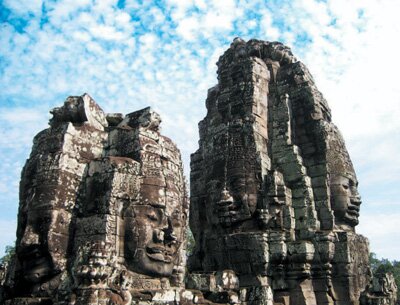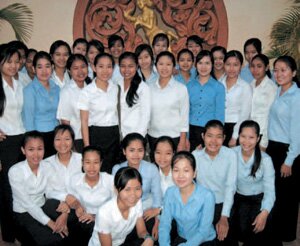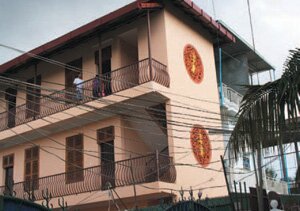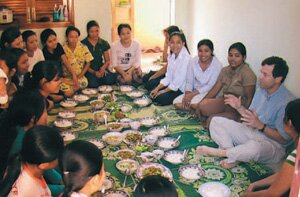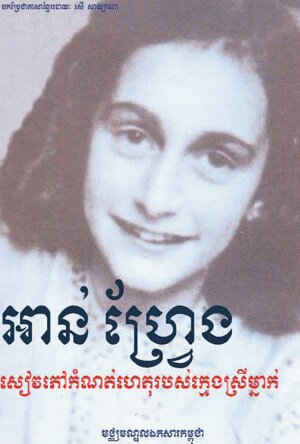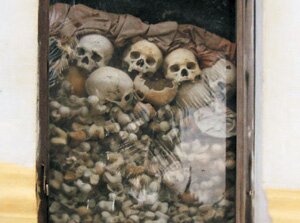| What's Jewish about Cambodia? |

|

|
The Kingdom of Cambodia borders Thailand to its west and northwest, Laos to its northeast, and Vietnam to its east and southeast. Most Cambodians are Theravada Buddhists of Khmer background, but the country also has a substantial number of predominantly Muslim Cham, as well as ethnic Chinese and Vietnamese. The country's population is over 13 million people and the capital and largest city is Phnom Penh. While today it is becoming an increasingly popular tourist destination for everyone from the backpacking set to the Frommer's guide touting five star tourists, the age-old beauty of Angkor Wat and its many temples stands in the shadows of the horrific legacy left by the Khmer Rouge. Researchers estimate that from 1975 to 1979, Pol Pot and the Khmer Rouge soldiers killed 1.7 million Cambodians, over 21 percent of the population of the country. Other estimates put death tolls as high as three million. Many of these murders took place in the "killing fields", the most infamous of which is Choeung Ek, just nine miles from Phnom Penh. Also infamous was the Tuol Sleng prison, once a school, where prisoners were tortured and killed. Today those infamous "killing fields" are attracting tourists as is the Tuol Sleng Museum of Genocide in Phnom Penh. Visitors stand and gasp at the sight of hundreds of skulls, taken from victims, piled in a stupah. While there are photographs of these stupahs readily available on the web and in books, still nothing compares to seeing them firsthand.
While the killing fields of Phnom Penh are well known and included in all tourist guides, less known is the skull filled stuppah memorial and killing field of Siam Reap, tucked behind Le Meridien Angkor. The hotel's driver and reception at first claimed that they had no idea about this memorial. When pressed, they insisted that it is not somewhere that tourists would want to visit. As Jews, we are obligated to pay respects and acknowledge these atrocities. There is little sense in comparing atrocities or in entering debates on whether the Cambodians can call this a holocaust or genocide. The reality is that visiting Cambodia as a Jew brings about a different perspective, a true empathy for their suffering. It raises the question again, "where was the world when these atrocities were being committed?" We do not need to be reminded, as Jews, that we can not turn a blind eye. We have an obligation to never forget. Perhaps this is, in part, what draws us here. And we continue to come. Hoards of Israeli backpackers come through each year. The Jewish expatriate community is dwarfed by comparison. Estimates put this community at under thirty, yet they got Chabad's attention. In 2007, the first ever organised Yom Kippur service was held in Cambodia. At the Hotel Intercontinental, in Phnom Penh, young Lubavitch rabbis traveled the globe to reach out to this isolated community. It is a guess that a permanent, organised Jewish community here is not far off. Israel has had official diplomatic relations with Cambodia since 1993 though there is no resident ambassador. Relations are officially maintained by the Israeli Ambassador to Thailand; currently Yael Rubenstein fills this role. It is a role that also seems to be growing. Recent reports indicate that Israel is set to become a major investor in Cambodia and new markets are being looked at including investment in agriculture, real estate, high tech industry and irrigation. The Phnom Penh Post recently ran an article that indicated that Israel was looking towards opening an offi cial representative office in Cambodia as well. Cambodia does represent opportunity as their economy begins to move slowly forward. Importantly, institutions such as The Documentation Center of Cambodia (DC-Cam) look toward the future of the people while recognising the importance of remembering the past. They have taken to the careful preservation and recording of the history of the Khmer Rouge years. Recognising the link between the Cambodians and the community of world Jewry, the Anne Frank translation project was initiated in 2000 with support from then-ambassador to Cambodia from the Netherlands, Ms. Laetitia van den Assum. The publication was funded in 2002 by the Royal Netherlands Embassy in Bangkok and translated by a Cambodian, Sayana Ser, who began work as a volunteer for DC-Cam in 1998. Ms. Ser was born in 1981, just two years after the fall of the Khmer Rouge, but was deeply affected by the aftermath and grew up hearing stories of her family's suffering and struggle for survival. Her family was evacuated from Phnom Penh and forced into hard labour. Three of her grandparents and many other relatives perished during the regime from 1975-1979. Notably, she compiled an extensive and important collection of poems, songs and slogans of the Khmer Rouge.
She was personally touched by the story of Anne Frank. The Ambassador to Cambodia from the Netherlands, Gerard J.H.C. Kramer, stated, "Anne Frank's ordeal bears resemblance to the personal history of thousands of Cambodians who have suffered a similar fate at the hands of the Khmer Rouge - That is why I am particularly pleased that Anne Frank's diary is now available in the Khmer language. I hope that many Cambodians will find something of relevance to their own lives and experience in this book and that it can be a source of comfort." Contemporary world Jewry is also reaching out and making a difference in the lives of Cambodians. There have been a number of humanitarian missions coordinated to bring medical care to Cambodians. There are also numerous Jewish founded organisations and foundations focused solely on providing aid to Cambodia, most with a strong focus on education. This emphasises the Jewish value for education as well as recognises the fact that intellectuals were targeted specifically by the Khmer Rouge. Notably, the Harpswell Foundation, founded in 1999, has taken to helping rebuild education in the country as the intellectual class was almost entirely obliterated by the Khmer Rouge. In June 2005, the Harpswell Foundation completed a four-room primary school in the village of Tramung Chrum. They maintain the school and its teaching staff. Furthermore, they developed a scholarship programme that allows the schools' best pupils to continue on at a secondary school. In 2005, they completed construction on a women's dormitory, one of the few in the country. The dormitory allows women from the provinces, 90% of the country's population, to have the opportunity to attend university as schools in Cambodia do not have housing. Male students are not as affected by this obstacle as they have the opportunity to fi nd housing in nearby Buddhist temples. The foundation also created a leadership centre for women. In May 2008, Alan Lightman, founding director of the Harpswell Foundation, was awarded the Gold Medal for Humanitarian Service to Cambodia by the government of Cambodia for his work. Lightman indicated to Jewish Times Asia, that while the foundation is not a Jewish organisation, he of course is in part driven to aid Cambodia by his own Judaism.
The Tokyo-based American Bernard Krisher also founded and heads a development project, the American Assistance for Cambodia/Japan Relief, initially aimed to see to the construction of 275 schools in Cambodia, aiding hundreds of thousands of children. Most of the funds and equipment for this massive development project has come directly through Krisher's massive network of contacts, with fund matching for the schools from the World Bank and the Asian Development Bank. Krisher ultimately has been instrumental in the founding of nearly 400 schools. Bernard Krisher was awarded Cambodia's highest honour -- the medal of Grand Officier de l'Ordre royal du Cambodge by the King-Father Norodom Sihanouk himself. As a German Jew, Krisher too has stated that he was able to easily identify with the struggles of the Cambodians based on his personal history as a refugee from the Holocaust. His work in Cambodia is far from over with projects extending to help all segments of the population from medical care, housing to agriculture. Even young people are connecting with the struggle of Cambodians. Seventeen year old Rachel Rosenfeld, a member of the Jewish Community of Harrison, NY, raised US$52,000 enough to open up the R.S. Rosenfeld School in Cambodia. This primary school in the rural village of Srah Khvav now is able to provide an education for 316 students. She also received support from the World Bank and the Asian Development Bank. Rachel was inspired after reading a New York Times article on the plight of teenage girls in Cambodia. She discovered through the American Assistance for Cambodia website that a mere US$13,000 could build a school in Cambodia and have a real impact on people's lives. For many Jews, Cambodia may be far away on the other side of the globe. Its customs, culture, religion and food may be something very foreign to us, but in the end it is in the hearts of the people where our connection lies. Cambodia again reminds the world never to forget and that we can not afford to remain complacent. (Issue February 2009) |
















